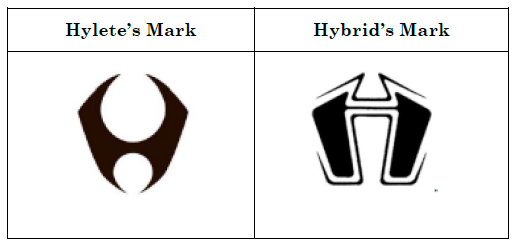Don’t raise issues for the first time before the CAFC unless it falls into one of the limited exceptions: the CAFC affirms the stylized letter “H” mark to be confusingly similar
| September 3, 2019
Hylete LLC v. Hybrid Athletics, LLC
August 1, 2019
Moore, Reyna, Wallach (Opinion by Reyna)
Summary
On appeal, Hylete LLC (“Hylete”) argued, for the first time, that the Board erred in its analysis by failing to compare its stylized “H” mark with “composite common law mark” of the Hybrid Athletics, LLC (“Hybrid”), comprising of the stylized letter “H” appearing above the phrase “Hybrid Athletics” and several dots underneath. By not presenting the argument during the opposition proceedings or at the request for reconsideration, the CAFC held that Hylete waived its argument, and upheld the decision of the Board.
Details
Hylete LLC applied to register a design mark for a stylized letter “H” in International Class 25 for “[a]thletic apparel, namely, shirts, pants, shorts, jackets, footwear, hats and caps.” Upon examination, the mark was approved for publication, and the mark published for opposition in the Trademark Official Gazette on June 18, 2013. After filing an extension of time to oppose, on October 16, 2013, Hybrid Athletics, LLC filed a Notice of Opposition on the grounds of likelihood of confusion with its mark under Section 2(d) of the Lanham Act. Hylete and Hybrid’s marks are as shown below:

Hybrid pleaded ownership in Application No. 86/000,809 for its design mark of a stylized “H” in connection with “conducting fitness classes; health club services, namely, providing instruction and equipment in the field of physical exercise; personal fitness training services and consultancy; physical fitness instruction” in International Class 41. Hybrid also pleaded common law rights arising from its use of the mark on “athletic apparel, including shirts, hats, shorts and socks” since August 1, 2008. The following images were submitted by Hybrid as evidence to show the use of the mark on athletic apparel:

All of the images showed the stylized “H” mark appearing above the phrase “Hybrid Athletics” and several dots underneath the phrase.
Hylete’s argument before the Board focused on the two stylized “H” designs having a different appearance, with each mark having its own distinct commercial impression. On December 15, 2016, the Board issued a final decision, sustaining Hybrid’s opposition, concluding that Hylete’s mark is likely to cause confusion with Hybrid’s mark. Hylete filed a request for reconsideration of the Board’s final decision, including an argument that “[t]here was no record evidence demonstrating that consumers would view [Hylete’s] mark as a stylized H” as a part of its commercial impression argument. The Board found that this argument is contrary to Hylete’s own characterization of the mark in its brief, as well as the testimony of its CEO, which admitted that both logos were Hs. The Board rejected Hylete’s argument and denied the request for rehearing. Hylete appealed the decision of the Board to the CAFC.
On appeal, Hylete argued that the Board erred in its analysis by failing to compare Hylete’s stylized “H” mark with Hybrid’s “composite common law mark,” comprising of the stylized letter “H” appearing above the phrase “Hybrid Athletics” and several dots underneath, as shown below:

In its appeal brief, Hylete stated as follows: “this appeal may be summarized into a single question: is Hylete’s mark sufficiently similar to [Hybrid’s] composite common law mark to be likely to cause confusion on the part of the ordinary consumer as to the source of the clothing items sold under those marks?”
In response, Hybrid stated that the “composite common law mark” arguments were never raised before the Board and are therefore waived.
The CAFC considers arguments made for the first time on appeal under the following limited circumstances:
- When new legislation is passed while an appeal is pending;
- When there is a change in the jurisprudence of the reviewing court or the Supreme Court after consideration of the case by the lower court;
- Even if the parties did not argue and the court below did not decide, when appellate court applies the correct law, if an issue is properly before the court; and
- Where a party appeared pro se.
Hylete did not dispute that the argument was not raised before the Board. Instead, Hylete contended that the argument has not been waived, because the Board “sua sponte” raised the issue of Hybrid’s common law rights in its final decision. The CAFC disagreed, stating that Hylete’s failure to raise the argument in the request for reconsideration negates its contention.
As Hylete could have raised the issue of Hybrid’s “composite common law mark” in the opposition proceedings or in the request for reconsideration, but did not do so, and as none of the exceptional circumstances in which the CAFC considers arguments made for the first time on appeals applies, the CAFC held that the issues raised by Hylete on appeal have been waived.
As the only issues Hylete raised on appeal concerned Hybrid’s “composite common law mark,” the CAFC affirmed the decision of the Board.
Takeaway
- Raise all possible arguments prior to appeal.
- It seems that the record before the Board lacked evidence that the letter H is conceptually weak or diluted in the context of the goods or in general – perhaps more evidence before the Board would have helped Hylete in this case. At the same time, perhaps presenting such evidence is not desirable to Hylete, as that would be an admission that its own mark is weak.


